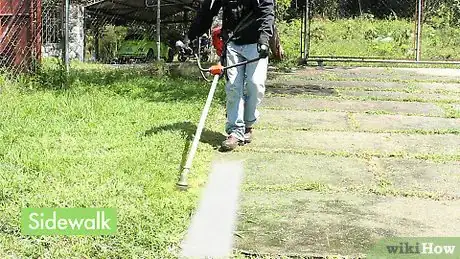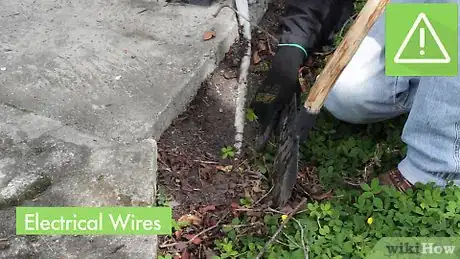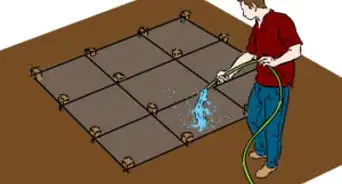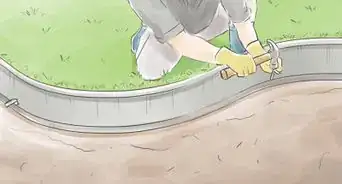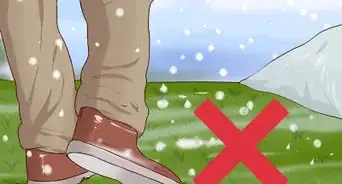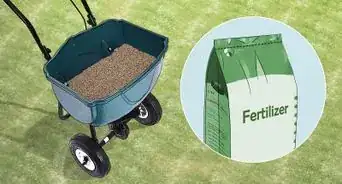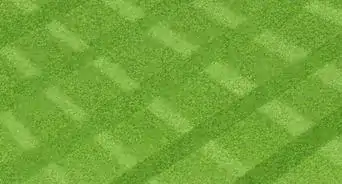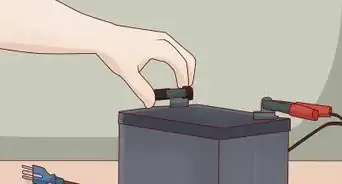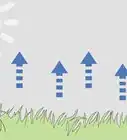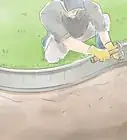This article was co-authored by Tony Hoang and by wikiHow staff writer, Hannah Madden. Tony Hoang is a Landscaper and the Principal at H&J Landscaping & Concrete Contractor in Newark, CA. With over six years of experience, he specializes in designing the perfect concrete driveways & backyard patios for homes. H&J Landscaping & Concrete Contractor is a 4.5-star business on Yelp.
There are 11 references cited in this article, which can be found at the bottom of the page.
wikiHow marks an article as reader-approved once it receives enough positive feedback. In this case, 100% of readers who voted found the article helpful, earning it our reader-approved status.
This article has been viewed 443,446 times.
When the snows of winter melt, you have a lawn that needs maintenance. After you have fertilized and watered, turn your attention to edging and mowing. It is easier to do the job correctly, so learn how to edge a lawn. All you need to do is periodic lawn maintenance once you have established clean edges around yard borders, shrubs, trees, planters and flower beds.
Steps
Edging Using a Power Edger or Weed Wacker
-
1Use your power edger or weed wacker primarily around sidewalks and footpaths.[1] When you edge your lawn, you have two options for which tool to use: You can use an electric or gas-powered edging tool, or you can use a manual edging tool.[2] (We'll explain about the manual edging tool later.) Because you don't have the space to dig out extra mulch or dirt around sidewalks and footpaths, it's best to use a power edger in these situations. Power edgers will make short work of these borders.[3]
- Opt for a power edger that is cheap, light, and straight. You can get power edgers relatively inexpensively, and you should — because who wants to spend a bunch of money on an edger? Opt for a light edger because you could spend longer amounts of time holding it up. And finally, unless you feel you need the "ergonomic" option, go for an edger with a straight body; it'll be easier to define a straight edge with one of these tools.
- When you purchase the edger, buy one or two replacement blades for it as well. The blades can really take a beating, even with the most practiced person running the edger. Be sure you also understand how to change out the blades when needed.
- There are some models of weed whackers that feature a multi-head design, meaning you can convert it into three or four other tools. This will cost considerably more than a straight weed wacker, but it may be worth it.
- Be sure you also have all the necessary safety equipment, including safety goggles/eyewear, long pants and boots, and earplugs.
-
2Use your power edger along straight lines and right angles. A power edger is much more efficient than a manual edger, but that doesn't mean that it always gets the job done better. A power edger is great around straight lines, or lines where a raised footpath can guide you. A power edger is not so great around lines where the boundaries aren't so well defined; in these areas, where you want the edge to flow, it's best to use a manual edging tool if you can afford to.Advertisement
-
3Walk holding the edging tool completely level and rigid. You want your body to move, not your arms. So turn the edging tool on, give it a little bit of power, and start slowly walking with the tool, holding your arms steady. Moving your body instead of your arms will ultimately make the cut on the grass much straighter.
-
4If you can, walk on the sidewalk or footpath as you edge. Instead of walking on the grass itself when you edge, walk on the sidewalk or footpath. Here's why: when you hold the edger out with your arms, your body naturally wants to bring your arms back closer to your body. If this happens when you're standing on the lawn itself, you start cutting into the lawn instead of merely lopping off the farthest edge. Over time, you'll find yourself redefining the edge each time (farther into your lawn) instead of using the same edge as a guide.[4]
- If you're standing on the sidewalk while edging, however, your body's impulse to bring in your arms as you move along the border means much less damage, because you'll be edging air when your body autocorrects. This is an easy problem to fix, because it's not a problem at all.
- In addition, the sidewalk or pathway is most likely a more even, flatter surface than the lawn. Walking on the sidewalk can help you keep a steady pace.
-
5Edge slowly but surely, taking time so that you don't have to rehash the same territory too many times. Power edgers are, well, powerful, so it's tempting to blaze through your lawn in record time. Too often, however, lazy execution produces lazy results. Take your time when you edge using a power tool. You'll find that you won't have to re-edge the same spot over and over again to achieve a clean look. Re-edging the same spot over and over again is likely to lead to a sloppy look.[5]
- Remember to locate and mark any sprinkler heads to avoid damaging them.[6]
Edging With a Manual Tool
-
1Get familiar with your half-moon manual edging tool. Your half-moon edger has a large blade in the shape of a half moon with an overhanging lip in the middle of the circle. This lip hits against soil at a uniform level every time you drive the half-moon into the ground, producing an even depth with each edge.[7]
- Simply drive the edging tool into the ground as you would a shovel, down until the lip hits soil, rocking the edger from side to side, and then pull the handle back gently to dig soil and define your edge. Once you've defined your edges, take a shovel and shovel up any loose soil or mulch into a wheelbarrow.
- When using a manual edging tool, drive the half-moon into the ground completely straight (vertically), not at an angle. Not only will this help define your edge more clearly, but it will also inhibit the growth of rhizomes from growing into the edges of your lawn.
- Maintain your edging tool. Clean off any dirt or debris after each use. File away the edges of the half moon periodically to keep them sharp. There's nothing better than a sharp tool, and nothing worse than a dull one.
-
2Use your manual edging tool to create fluid or flowing edges. Against the slight curve of a planting bed, the edging tool works fantastically. Simply spray paint your curved edge or lay down a garden hose onto the edge you want to create, and edge away. Of course, if you decide to use a garden hose as your guide, be extremely careful not to accidentally cut into it with your edging tool.
-
3Be careful of electrical wires, plumbing pipes, and other subterranean hazards as you edge. Although they may be covered with PVC pipe that's difficult to cut into with an edger, it's better to be safe than sorry. Talk to your utilities company before edging out any large stretch of lawn and remember to edge gingerly.
-
4Edge around flower beds and planters with a manual edge. Flower beds and planters are perfect for using a manual edge because you can afford to take away a little soil or mulch when you edge. The process is the same. Just remember not to take away too much lawn when you edge; try to achieve the balance of taking away just enough to clearly define the edge but not so much that you've significantly reduced your lawn space.[10]
-
5Decide how you want to tackle trees and shrubs. The lawn around trees and shrubs can be edged either with a power edger or a half-moon. When using a half-moon, however, be especially careful of root growth. If the tree or shrub is older or has an extensive root system, consider edging with a power edger instead of actually digging into the soil and potentially cutting up roots.
Expert Q&A
Did you know you can get expert answers for this article?
Unlock expert answers by supporting wikiHow
-
QuestionWhat can I use to edge my lawn if I don't have an edger?
 Jeremy YamaguchiJeremy Yamaguchi is a Lawn Care Specialist and the Founder/CEO of Lawn Love, a digital marketplace for lawn care and gardening services. Jeremy provides instant satellite quotes and can coordinate service from a smartphone or web browser. The company has raised funding from notable investors like Y Combinator, Joe Montana, Alexis Ohanian, Barbara Corcoran and others.
Jeremy YamaguchiJeremy Yamaguchi is a Lawn Care Specialist and the Founder/CEO of Lawn Love, a digital marketplace for lawn care and gardening services. Jeremy provides instant satellite quotes and can coordinate service from a smartphone or web browser. The company has raised funding from notable investors like Y Combinator, Joe Montana, Alexis Ohanian, Barbara Corcoran and others.
Lawn Care Specialist
-
QuestionIs it best to edge soil when it is dry, damp, or soaked?
 Andrew Carberry, MPHAndrew Carberry is a Food Systems Expert and the Senior Program Associate at the Wallace Centere at Winrock International in Little Rock, Arkansas. He has worked in food systems since 2008 and has experience working on farm-to-school projects, food safety programs, and working with local and state coalitions in Arkansas. He is a graduate of the College of William and Mary and holds a Masters degree in public health and nutrition from the University of Tennessee.
Andrew Carberry, MPHAndrew Carberry is a Food Systems Expert and the Senior Program Associate at the Wallace Centere at Winrock International in Little Rock, Arkansas. He has worked in food systems since 2008 and has experience working on farm-to-school projects, food safety programs, and working with local and state coalitions in Arkansas. He is a graduate of the College of William and Mary and holds a Masters degree in public health and nutrition from the University of Tennessee.
Food Systems Expert
-
QuestionHow wide a space do I need to stop grass from continuing to grow?
 Andrew Carberry, MPHAndrew Carberry is a Food Systems Expert and the Senior Program Associate at the Wallace Centere at Winrock International in Little Rock, Arkansas. He has worked in food systems since 2008 and has experience working on farm-to-school projects, food safety programs, and working with local and state coalitions in Arkansas. He is a graduate of the College of William and Mary and holds a Masters degree in public health and nutrition from the University of Tennessee.
Andrew Carberry, MPHAndrew Carberry is a Food Systems Expert and the Senior Program Associate at the Wallace Centere at Winrock International in Little Rock, Arkansas. He has worked in food systems since 2008 and has experience working on farm-to-school projects, food safety programs, and working with local and state coalitions in Arkansas. He is a graduate of the College of William and Mary and holds a Masters degree in public health and nutrition from the University of Tennessee.
Food Systems Expert
Warnings
- Don't scrape the edger blade against concrete. You'll ruin the blade.⧼thumbs_response⧽
- Make sure no one else is near when you are running the edger as it throws debris.⧼thumbs_response⧽
- Make sure you wear the proper safety gear when edging your lawn — safety eyewear, earplugs, long pants, and boots.⧼thumbs_response⧽
- Don't be careless as you work with the edger. Its sharp blade can cause injury.⧼thumbs_response⧽
Things You'll Need
- Lawn edger
- Shovel
- Decorative rock or stone
References
- ↑ https://www.lowes.com/n/how-to/edge-landscape-power-lawn-edger
- ↑ Keith Souza. Home Improvement Specialist. Expert Interview. 20 August 2021.
- ↑ https://www.turfmagazine.com/maintenance/trimming-and-edging-the-right-way/
- ↑ https://www.farmandfleet.com/blog/use-lawn-edger/
- ↑ https://www.youtube.com/watch?v=tKaXIgU7pMA
- ↑ Keith Souza. Home Improvement Specialist. Expert Interview. 20 August 2021.
- ↑ https://www.bobvila.com/articles/how-to-edge-a-lawn/
- ↑ Keith Souza. Home Improvement Specialist. Expert Interview. 20 August 2021.
- ↑ http://call811.com/811-your-state
- ↑ https://www.homerepairtutor.com/how-to-edge-a-flower-bed/
- ↑ Tony Hoang. Landscaping Manager. Expert Interview. 12 December 2022.
- ↑ Tony Hoang. Landscaping Manager. Expert Interview. 12 December 2022.
- ↑ Tony Hoang. Landscaping Manager. Expert Interview. 12 December 2022.
- ↑ https://www.popularmechanics.com/home/lawn-garden/g2527/9-mowing-tips-for-the-best-lawn-this-summer/
- http://www.rlrouse.com/mow-edge.html
About This Article
If you want to edge your lawn, start by turning on your power edger and walking with the edger held completely level. If you can, walk on the footpath while you edge and keep your arm steady to make the grass cut much straighter. For best results, work slowly with your edger rather than trying to rush around your lawn. When you need to edge parts of your lawn that don't have straight edges, try using a manual edging tool rather than a power edger as this will make your job easier. For tips on how to maintain your edging tool and what safety equipment to wear while edging, read on!

